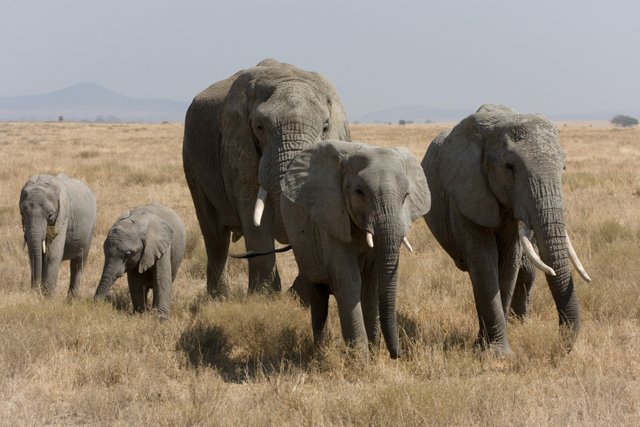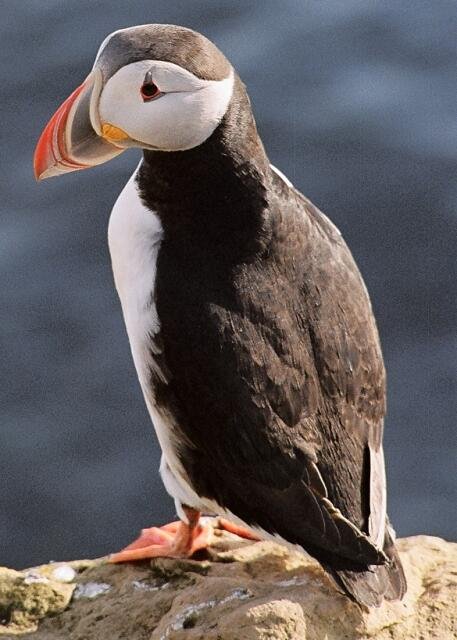Why some animals only get one offspring, while others get hundreds
Some animals can produce tens of thousands offspring from a single mating, while others are only able to produce a single offspring each year. Have you ever wondered why nature works like this? Well, you are going to find out if you continue to read this post!

The African Elephant (Loxodonta africana) give birth to only a few offspring, but will provide lots of parental care to make sure they survive. You can see that the offspring are all of different size, so they are not from the same mating. Image by Ikiwaner, posted with the GNU Free Documentation License.
The theory that was used to explain the big difference in produced offspring is coined the r/K selection theory. This theory was replaced by the Life history theory in the 1990s, but knowing about the r/K selection theory will go a long way to explain the big differences in offspring production in the animal kingdom.
The r/K selection theory is based upon putting animals into either the r or the K-selected group based upon the quality and quantity of the offspring produced. Let us take a quick glance at each group:
r-selected animals
The r-selected species are animals that typically produce a large quantity of offspring, hence the r is short for rate. Each offspring will have a low survival rate, but the sheer amount of offspring will make it statistically likely that enough offspring will survive long enough to be able to reproduce and continue the cycle.
Most r-selective animals produce relatively undeveloped offspring, and provide little or none parental care. One would expect this species to be have a short life expectancy, small body size, an early maturity, and the ability to disperse easily.
These animals are prone to dominate in unpredictable environments where a good environment will make the amount of animals very high. This is for example seen in some rodent species in Northern Hemisphere alpine biotopes, where a summer that provides good conditions for the rodents will lead to an insane number of rodents in the mountain area.
A lemming (Lemmus lemmus). These can have high densities with good conditions, and are a very typical r-selected species. In Norway, we even have a term which translate into “Lemming Year”. This is used when there are good conditions for the lemming, and we can find hundreds of them on the alpine zones. You will be flooded by them if you are going for a hike during these years! Image by Mouagip, posted as Public Domain under the Creative Commons CC0 1.0 Universal Public Domain Dedication.
There are many examples of r-selected species, such as most rodents, most fish, most insects, and in general most small animals that can produce many offspring each year.
K-selected animals
The K-selected animals are the opposite of the r-selective ones. They are generally large, have a somewhat long gestation period (number of days pregnant), and produce few offspring from each mating. The offspring has a much higher chance to survive into adulthood than the r-selected offspring, so the general survival rate is high.
The K comes from the German word Kapazität, which means Carrying capacity. This term is used because K-selected species usually live close to the carrying capacity of the environment, where they live in an equilibrium. In contrast to the r-selected species, a single year with perfect conditions will not affect the population size a lot. This means that these species will prefer a stable environment where they can live in an equilibrium with the carrying capacity, which again means that the population will be about constant.
The K-selected species will have a longer life expectancy, and provide lot of parental care. Just think of yourself, because humans are K-selected species (with the exception that we refuse to live in an equilibrium with the carrying capacity!). Most humans only produce one or two offspring, and take care of them for 18+ years before they are left to take care of themselves. Elephants and whales are pretty much the same way, along with many of the other big animals.
You do not necessarily have to take care of your offspring for 18 years to be a K-selected species. The Atlantic puffin (Fratercula arctica) is a good example. This is actually a pretty small bird, but it will have to be 4-5 years before it matures. After that each bird will only produce one egg each year, and take good care of its offspring. The life expectancy is around 25 years, but there are birds recorded to be over 34 years old.

The Atlantic Puffin, a typical K-selected bird. Image by Tomi, posted with the Creative Commons Attribution-Share Alike 3.0 Unported license.
The Atlantic puffin is a good example of a K-selected species, because most of the other birds that are its size are r-selected (like most of the grouse species), and can produce 5-10+ offspring yearly after becoming mature at about one year of age.
Most species are somewhere in-between
Despite having these two groups, most animals are somewhere in-between the groups. There are of course the extreme ends of the spectrum, like elephants that are pregnant for 22 months, or fish that lays 100,000+ eggs, but rodents are for example r-selective, but might only be able to produce 50 offspring a year, which is very small compared to some fish and insect species. They are still considered a good example of r-selected species, but their number of offspring will never even be close to that of some fish or insect species, which shows that there is a spectrum here, not just two groups.
We usually find a lot of reptiles such as sea turtles in the middle. Some of these species are very long-lived, but still produce very many eggs annually.
It is all about trade-offs
In ecology, a trade-off is when you have to pick either one strategy or another, because the organism does not have enough energy to use both strategies. In this example, the organisms that produce a lot of offspring have to trade-off the ability to provide good parental care, and rather use all its energy to create as many as possible. The K-selected species will focus all their energy on making sure their few offspring will be able to survive into adulthood.
Because animals only have a limited amount of energy, they are not able to pick both strategies, and each species must pick one strategy, or a combination that are within their energy limits. If a fish produce 100,000 eggs, it obviously cannot provide good parental care for all of them, like it could be able to if it only have a couple of offspring.
Why scientists moved away from the r/K selection theory
The r/K selection theory is still used a lot in ecology studies, but it is less used now in modern times because it has very few categories. It is very difficult to put every single organism on the earth into either one or the other group, so scientists moved over to using the Life history theory, which is based on how natural selection has shaped each organism, and include information about juvenile development, age of sexual maturity, number of offspring, first expected reproduction, level of parental investment, expected age of death etc.
This theory is more based upon each single species, and can give a lot of information about the species quickly without having to put it into either the r or the K-selected groups.
Thanks for reading
Thank you for reading my post about r/K selection theory, which explained how some animals can produce lots of offspring, while other produce very few.
This post is based upon the r/K selection theory in animals, but can also be used for plants, bacteria and most other organisms. However, it looks a little different for some other organisms, like the trees. They usually live for a very long time (typical K-selective), but also produce a very large amount of offspring (typical r-selective), so they can be a bit tricky to place correctly.
Anyway, if you enjoyed the read, make sure to leave a comment below and follow my profile ( @valth )! I create posts like these pretty often, so follow me to make sure you don’t miss out on any.
Sources
- Ecology: Concepts and Applications, 6th edition by Manuel C. Molles Jr. Chapter 12.3, page 270 - 276.
This is a pretty commonly used concept in ecology studies, so most ecology text books will have lots of information about these theories.
Great article @valth, well written in my opinion :D
Thank you! :)